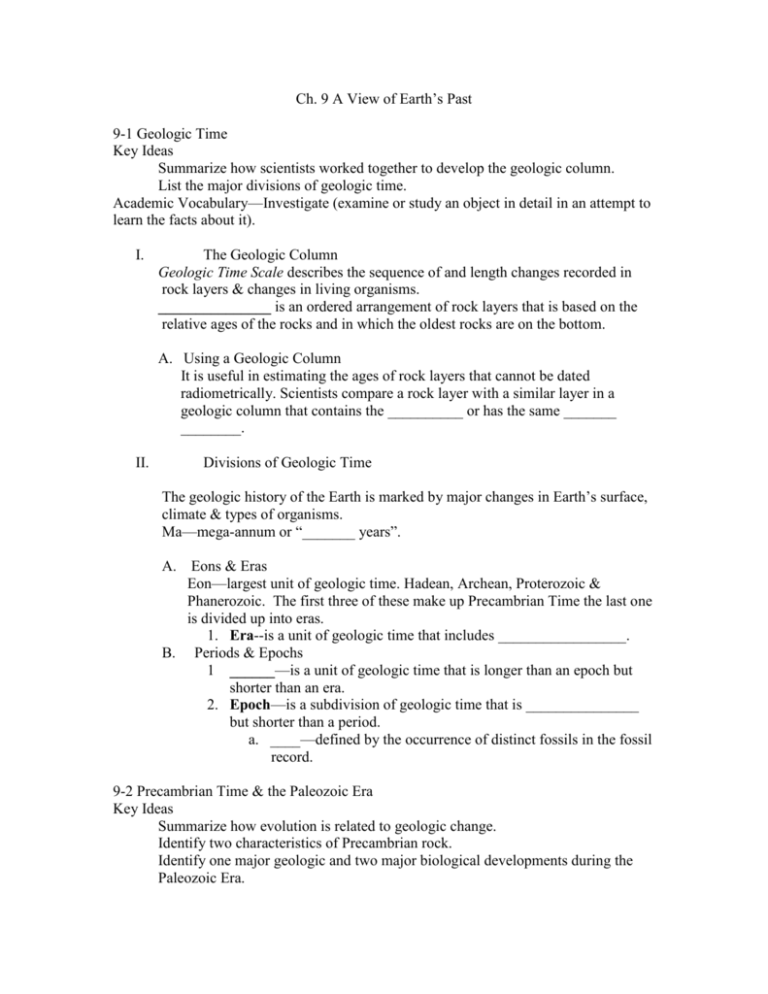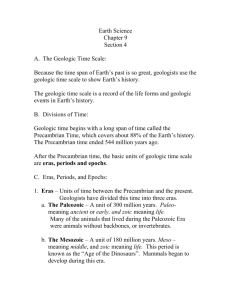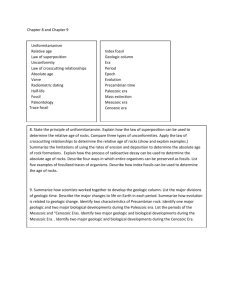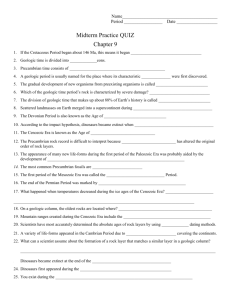Copy of A View of Earth`s Past Fill in Notes
advertisement

Ch. 9 A View of Earth’s Past 9-1 Geologic Time Key Ideas Summarize how scientists worked together to develop the geologic column. List the major divisions of geologic time. Academic Vocabulary—Investigate (examine or study an object in detail in an attempt to learn the facts about it). I. The Geologic Column Geologic Time Scale describes the sequence of and length changes recorded in rock layers & changes in living organisms. _______________ is an ordered arrangement of rock layers that is based on the relative ages of the rocks and in which the oldest rocks are on the bottom. A. Using a Geologic Column It is useful in estimating the ages of rock layers that cannot be dated radiometrically. Scientists compare a rock layer with a similar layer in a geologic column that contains the __________ or has the same _______ ________. II. Divisions of Geologic Time The geologic history of the Earth is marked by major changes in Earth’s surface, climate & types of organisms. Ma—mega-annum or “_______ years”. A. Eons & Eras Eon—largest unit of geologic time. Hadean, Archean, Proterozoic & Phanerozoic. The first three of these make up Precambrian Time the last one is divided up into eras. 1. Era--is a unit of geologic time that includes _________________. B. Periods & Epochs 1 ______—is a unit of geologic time that is longer than an epoch but shorter than an era. 2. Epoch—is a subdivision of geologic time that is _______________ but shorter than a period. a. ____—defined by the occurrence of distinct fossils in the fossil record. 9-2 Precambrian Time & the Paleozoic Era Key Ideas Summarize how evolution is related to geologic change. Identify two characteristics of Precambrian rock. Identify one major geologic and two major biological developments during the Paleozoic Era. Academic Vocabulary—expose (to present to view; to reveal; to uncover) I. Evolution Evolution is the ______________ by which new species develop from preexisting species over time. Evidence includes the similarity in skeletal structures of animals. A. Evolution and Geologic Change Geologic changes result in changing ___________ conditions. As a result, populations either evolve or become _______. II. Precambrian Time ___________ Time is the interval of time in the geologic time scale from Earth’s formation to the beginning of the Paleozoic Era, from 4.6 billion to 542 million years ago. -makes up ____ of Earth’s history -lack information about much of this time A. Precambrian Rocks ______ are large areas of exposed Precambrian Rocks. Most are highly deformed & contain few fossils. B. Precambrian Life __________ are layered, reef-like deposits that contain cyanobacteria. Fossils are rare from this time probably because life that existed lacked parts that can be made into fossils. III. The Paleozoic Era __________ Era is the geologic era that followed Precambrian time & that lasted from 542 million to 251 million yrs. ago. Pangaea— a ____________ that formed at the end of the Paleozoic Era. A. The ________ Period Warm, shallow seas covered much of the continents so a large explosion of invertebrate life thrived under these conditions. 1. ________ were most common & are used as index fossils. 2. Brachiopods were a ______ animal 3. Worms, jellyfish, snails & sponges are also included. B. The _________ Period—very little plant life on land 1. Invertebrates—Brachiopods, bryozoans, cephalopod mollusks, corals & _________. 2. Vertebrates—jawless fish C. The _______ Period—earliest vascular land plants appear toward the end 1. Echinoderms & corals become common. Underwater scorpion-like eurypterids also existed. D. The ________ Period—Age of Fishes 1. Lungfish—ability to breathe air. 2. Rhipidistians—may have been able to crawl on land. 3. Ichthyostega—ancestor to modern amphibians. 4. Land Plants like giant horse tails ferns & seed-bearing plants develop. E. The ___________ Period—“Carbon Bearing” Warm, humid climate. Forests & swamps covered most of the land. 1. Crinoids were common in the ocean 2. Divided into Mississippian & Pennsylvanian. 3. Insects common on land. 4. Early reptiles toward the end. F. The _______ Period End of this time is marked by a _____________ which marked the end of many marine invertebrates. Fossils indicate that reptiles & amphibians survived the environmental changes brought about by the formation of _______. 9-3 The Mesozoic & Cenozoic Eras Key Ideas List the Periods of the Mesozoic & Cenozoic Eras. Identify two major geologic & biological developments during the Mesozoic Era. Identify two major geologic & biological developments during the Cenozoic Era. Academic Vocabulary—dominant (having the greatest effect; most numerous. I. The Mesozoic Era Mass extinction—an episode during which large numbers of species become extinct. 90% of marine organisms & 70% of land organisms died at the end of the ____________. ________ Era is the geologic era that lasted from 251 million to 65.5 million yrs. ago; also know as the Age of _______. As Pangaea broke into smaller continents, shallow seas & marshes covered much of the land. The climate was warm & humid. A. The _______ Period 1. Dinosaurs flourished. 2. Cycads—cone bearing trees. 3. Ichthyosaurs lived in the oceans. 4. Ammonites (type of shellfish) serve as Mesozoic index fossils. 5. The first mammals appear—small rodent-like forest dwellers. B. The _______ Period 1. Dinosaurs—dominant life-form. Two major groups: a. Saurischians or “lizard-hipped” Ex: Apatosaurus. b. Ornithischians or “bird-hipped” Ex: Stegosaurus & Pterosaurs. 2. Earliest Birds--Archaeopteryx C. The _________ Period 1. Dinosaurs—continue to dominate D. a. Tyrannosaurus Rex—__________ b. Ankylosaurus, Ceratopsians, Hadrosaurs—________ 2. Plant life—___________ became the dominant. The Cretaceous-Tertiary Mass Extinction 1. Another mass extinction ends the Cretaceous Period. a. Impact hypothesis—_________ yrs. ago an asteroid crashed into Earth. b. Environmental changes due to continental drift & volcanic activity. II. The Cenozoic Era The Cenozoic Era is the current geological era, which began 65.5 million yrs. ago, also called the Age of ________. A. B. C. D. E. F. The Tertiary & Quaternary Periods 1. _______—includes time before the last ice age. Includes 5 epochs a. Paleocene b. Eocene c. Oligocene d. Miocene e. Pliocene 2. _________—time from the last ice age to the present. Includes 2 epochs. a. Pleistocene b. Holocene The Paleocene and Eocene Epochs 1. Paleocene—_____________________ 2. Eocene—earliest ancestor of the _____. The Oligocene & Miocene Epochs 1. Oligocene—deer, pigs, horses, camels, cats & dogs flourished. 2. Miocene—largest known ____ mammals. The Pliocene Epoch 1. ________—bear, dog & cat families. 2. Herbivores—giant ground sloth, modern horses. The Pleistocene Epoch 1. Woolly _________ & woolly ______. 2. Fossils of earliest modern _______ discovered in Pleistocene sediments. The Holocene Epoch—began about 11,500 yrs. ago 1. Modern humans developed _________ & made tools of bronze & iron.








